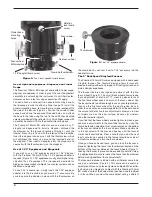
3
observing session, you can quickly reach focus by setting the
millimeter scale to the previously noted position.
A useful feature of the focuser is that it can be rotated relative
to the tube. This enables you to customize the orientation of
the focus wheels to the most convenient position. To rotate,
loosen the focuser rotation lock thumbscrew (Figure 2) by a
few turns while holding the focuser steady. Adjust the orienta-
tion of the focuser and then tighten the focuser rotation lock
thumbscrew to secure the desired position
calculating Magnification (Power)
It is desirable to have a range of eyepieces of different focal
lengths, to allow viewing over a range of magnifications. To
calculate the magnification, or power, of a telescope, simply
divide the focal length of the telescope by the focal length of
the eyepiece:
Telescope F.L. ÷ Eyepiece F.L. = Magnification
For example, the Premium 102mm ED, which has a focal
length of 714mm, used in combination with a 25mm eyepiece,
yields a power of 28.5x.
714 ÷ 25 = 28.5X
Every telescope has a useful limit of power of about 45x-60x
per inch of aperture. Claims of higher power by some tele-
scope manufacturers are a misleading advertising gimmick
and should be dismissed. This means the highest useful
magnification for the Premium 102mm ED is approximately
180-240x. Keep in mind that at higher powers, an image will
always be dimmer and less sharp (this is a fundamental law of
optics). The steadiness of the air (the “seeing”) will also limit
how much magnification an image can tolerate.
Always start viewing with your lowest-power (longest focal
length) eyepiece in the telescope. After you have located and
observed the object with it, you can try switching to a high-
er-power eyepiece to ferret out more detail, if atmospheric
conditions permit. If the image you see is not crisp and steady,
reduce the magnification by switching to a longer focal length
eyepiece. As a general rule, a small but well-resolved image
will show more detail and provide a more enjoyable view than
a dim and fuzzy, overmagnified image.
note about chromatic aberration
Chromatic aberration literally means color distortion.
Whenever light passes through one material to another, light
of different wavelengths (color) is bent by different amounts.
This is a problem that plagues refractor-type telescopes, since
light passes through both air and glass to form an image. Most
astronomical objects emit a spectrum comprised of many dif-
ferent wavelengths of light, so each wavelength will be bent
by a slightly different amount when passing through a lens.
This results in each color of light reaching precise focus at a
slightly different point, which reduces image sharpness.
The Premium 102mm ED is designed to minimize chromatic
aberration. The objective lens comprises two individual lens
elements, one of which is made of “ED” (Extra-low Dispersion)
glass, a special type of glass that has superior refractive prop-
erties compared to normal types of glass. The use of this ED
glass minimizes the amount of chromatic aberration, resulting
in a cleaner, sharper image compared to that in standard ach-
romatic refractors.
imaging with the Premium 102mm ED refractor
The Premium 102mm ED refractor’s f/7.0 optics make it an
excellent choice for astro-imaging. The telescope has been
designed with plenty of inward focus travel. This is a great
convenience for many imaging applications which require
additional devices, such as off-axis guiders and filter wheels,
between the telescope and camera. Without additional inward
focus travel, these devices would be difficult, if not impossible,
to use. As a consequence of this, extension tubes may be
necessary to reach focus with a camera if no other devices
are placed between the telescope and camera.
Using a digital SLR camera with the telescope requires a T-
ring for your model of camera and a 2" camera adapter. A 2"
extension tube may also be required.
To use the Premium 102mm ED with the Orion StarShoot
imaging cameras, an extension tube will generally be required.
No other camera adapters should be needed.
Contact Orion Customer Service at 800-676-1343 for more
details on camera adapter and extension tube options.
care & Maintenance
Give your telescope reasonable care and it will last a lifetime.
When not in use, keep its dust cover on as well as the dust cap
for the eyepiece opening. Store it indoors or in a dry garage.
Do not leave the telescope outside when not in use.
Orion offers a foam-lined hard case for the Premium 102mm
ED refractor which is an excellent choice for both storage
and safe transport of the telescope. Contact Orion Customer
Service for details.
The optical tube is aluminum and has a smooth painted sur-
face that should resist scratches and smudges. If a scratch
does appear on the tube, it will not harm the telescope.
Smudges on the tube can be wiped off with standard house-
hold surface cleaners.
Any quality optical lens tissue and cleaning fluid specifically
designed for multi-coated optics can be used to clean the
telescope’s objective lens as well as the lenses of eyepieces
and finder scopes. Never use regular glass cleaner or clean-
ing fluid designed for eyeglasses. Before cleaning with fluid
and tissue, blow any loose particles off the lens with a blower
bulb or compressed air, or lightly brush the lens with a soft
camel hair brush. Apply some cleaning fluid to a tissue, never
directly on the optics. Wipe the lens gently in a circular motion,
then remove any excess fluid with a fresh lens tissue. Oily fin-
gerprints and smudges may be removed using this method.
Use caution; rubbing too hard may scratch the lens! Clean
only a small area at a time, using a fresh lens tissue on each
area. Never reuse tissues.




